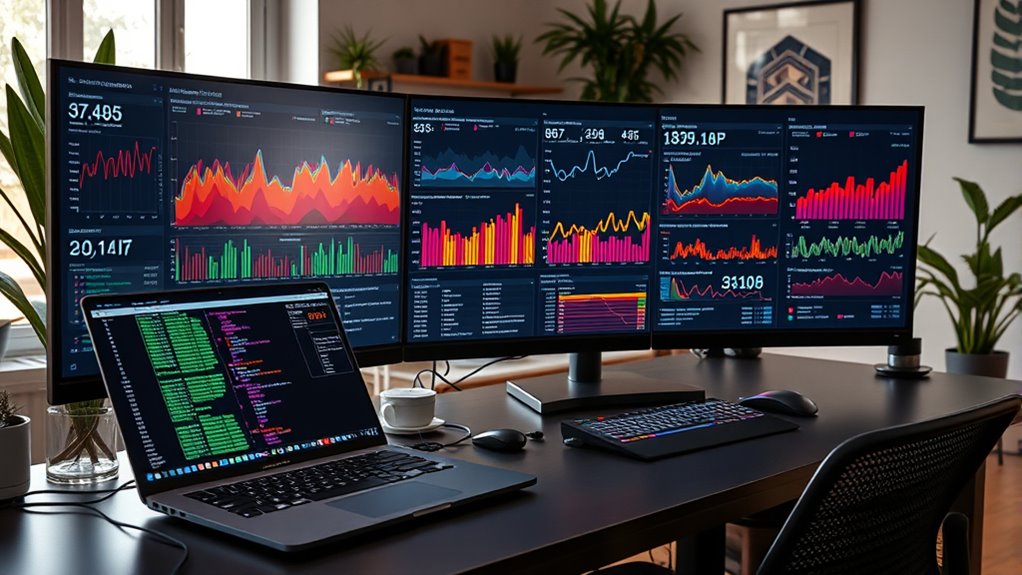To monitor your VPS with open-source tools only, start by choosing reliable options like Nagios, Zabbix, or Prometheus, which provide customizable dashboards and alert systems. Set up automated monitoring for server load, network latency, and resource usage such as CPU, RAM, and disk. These tools help you detect issues early and send alerts when anomalies occur. With the right setup, you’ll keep your VPS secure and efficient—if you keep exploring, you’ll discover even more ways to optimize your server management.
Key Takeaways
- Choose open-source monitoring tools like Nagios, Zabbix, or Prometheus for server performance tracking.
- Configure these tools to monitor key metrics such as CPU, RAM, disk usage, and network latency.
- Set up automated alerts to notify you immediately of anomalies or resource thresholds being exceeded.
- Create customizable dashboards for real-time visualization of server health and performance trends.
- Regularly update and fine-tune your monitoring setup to ensure proactive management and prevent outages.

In essence, monitoring your VPS with open-source tools isn’t just about catching problems; it’s about maintaining peak performance, security, and reliability. By regularly checking server load and network latency and setting up automated alerts, you gain the insights needed to keep your server running smoothly. Color accuracy With a proactive approach, you can prevent minor hiccups from escalating into major outages, ensuring your digital environment remains fast, secure, and dependable.
Frequently Asked Questions
Can Open-Source Tools Replace All Commercial Monitoring Solutions?
Open-source tools can often replace commercial monitoring solutions, especially when you consider the cost comparison—these tools are usually free, saving you money. Plus, a strong user community offers support, updates, and shared insights, making them reliable options. While they might lack some advanced features, many open-source options effectively monitor your VPS’s performance, security, and uptime, providing a viable, cost-effective alternative to expensive commercial solutions.
How Do I Secure Open-Source Monitoring Tools Against Attacks?
To safeguard open-source monitoring tools against attacks, you should implement security best practices, keep your software updated, and regularly patch vulnerabilities. You need to monitor access logs, enforce strong authentication, and manage permissions carefully. You must also conduct vulnerability management, perform regular security audits, and stay informed about new threats. By following these steps, you bolster your defenses, protect your system, and ensure your open-source tools stay resilient against potential attacks.
What Are the Best Open-Source Dashboards for VPS Monitoring?
You’re looking for the best open-source dashboards for VPS monitoring. Consider Grafana, which offers extensive dashboard customization and supports plugin integration, allowing you to tailor the interface to your needs. Zabbix provides an all-encompassing view with customizable dashboards and plugin support. Both tools enable real-time data visualization, making it easier to track your VPS performance and quickly identify issues, all while allowing flexible customization and seamless plugin integration.
How Do I Set up Alerts With Open-Source Monitoring Tools?
Oh, setting up alerts with open-source tools is a breeze—if you love diving into configs! First, define threshold alerts in your monitoring system like Zabbix or Nagios, setting specific metrics and limits. Then, connect notification systems like email or Slack to get instant alerts. It’s all about customizing your alerts so you’re notified the moment something’s off, keeping your VPS healthy without missing a beat.
Are Open-Source Tools Scalable for Large VPS Environments?
You might wonder if open-source tools can handle large VPS environments. While they’re flexible and customizable, scalability challenges can arise as your infrastructure grows. Proper resource management becomes vital to avoid performance issues, especially with high traffic or complex setups. By choosing the right tools and optimizing configurations, you can effectively monitor large environments, but be prepared to address potential limitations and plan for expansion accordingly.
Conclusion
Monitoring your VPS with open-source tools keeps your server reliable and secure. Did you know that 70% of server downtime is caused by misconfigurations or overlooked issues? By actively using tools like Nagios or Zabbix, you can catch problems early and prevent costly outages. Stay proactive, keep an eye on performance metrics, and you’ll guarantee your VPS runs smoothly, saving time and resources in the long run.









